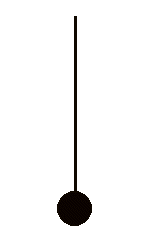Time and Frequency
 For systems that oscillate in a periodic fashion the quantities of time and frequency
offer two equivalent methods of quantifying the motion. Let's begin by considering
a simple oscillating system--the pendulum--the favorite of physics courses everywhere.
The pendulum in the animated gif below makes about 46 complete oscillations in 1 minute.
Try counting them. I know it's tough--it's the jerkiest (very unphysical) pendulum
I've ever seen but I made the animation myself (guess I won't be getting a call to
work at Disney's animation department).
For systems that oscillate in a periodic fashion the quantities of time and frequency
offer two equivalent methods of quantifying the motion. Let's begin by considering
a simple oscillating system--the pendulum--the favorite of physics courses everywhere.
The pendulum in the animated gif below makes about 46 complete oscillations in 1 minute.
Try counting them. I know it's tough--it's the jerkiest (very unphysical) pendulum
I've ever seen but I made the animation myself (guess I won't be getting a call to
work at Disney's animation department).
We can, with minimal math, translate 46 oscillations per minute into 1.304 seconds per oscillation. The time for one oscillation is called theperiodof the pendulum. Thus, the period of this pendulum is 1.304 s. Another way of expressing the periodic motion of the pendulum is as a frequency. Frequency is defined as the number of oscillations per second. Thus, if each complete oscillation take 1.304 seconds then the number of oscillations completed in 1 second is 1/1.304=0.767 Hz. Note that frequency is measured in Hertz (Hz) which is a more convenient name for 'per second' (or 1/second). Note that the frequency that we calculated for our jerky pendulum is less than one. This observation makes sense because it takes longer than 1 second to execute one complete oscillation, therefore in 1 second the pendulum only finishes 0.767 of an oscillation.
The relationship between time and frequency in mathematical terms is given by the equation
f = 1 / T
where T is the period of the oscillation and f is the frequency. This equation is very fundamental--remember it! Also it is simple algebra to rewrite the equation in terms of period, that is T=?.
Why have two different measurement methods for the same phenomenon, you may ask? For more complex oscillating systems we will see that the frequency and time perspectives give us different insights into the same information. However, even in the simple cases like a pendulum, we use period for oscillations that are typically a second or longer whereas for fast oscillations frequency is more a convenient unit of measurement. For example, a frequency of 5500 Hz is easier to grasp than a period of 0.000182 seconds.
OK to end lets try a few simple exercises that illustrate time and frequency for a number of everyday physical phenomena.
Self Test 1
-
What is the frequency and period of the average heartbeat? Assume that the average human's heart beats 72 times a minute.
-
A TV picture refreshes at 30 frames a second. What is the period corresponding to this refresh rate?
-
A certain tuning fork has tines that complete one period of oscillation in 2.27273 ms. What is the frequency of this vibrating tuning fork?
-
My computer has a clockspeed(actually frequency not speed) of 166 MHz (yes, I know old technology!). What is the period for 1 clock oscillation? [Remember MHz mean MegaHertz and the prefix Mega = 106.]
Send me an email at wroberts@mtsu.edu
Contact Information
Dr. W. M. Robertson
MTSU Box X-116
Murfreesboro, TN 37132
Ph. (615) 898-5837


